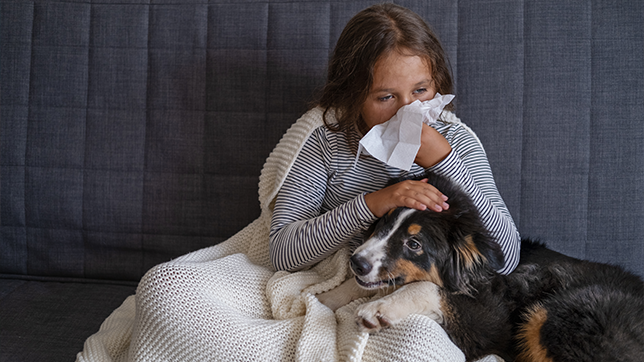16th May 2024
Can pets make hayfever worse?
Our pets bring so much joy to our lives that it’s difficult to imagine they’d have any connection to human hayfever. However, surprisingly, it is possible for our pets to make our own hayfever symptoms worse.
Let’s explore the ways pets might make hayfever worse, find out how to prevent your pets from affecting your hayfever, and other handy hints for helping to manage hayfever…
How do pets make hayfever worse?
Although people can be allergic to pet dander (skin cells shed by animals), airborne allergens may also be carried on pet hair. So, pollen can be carried on your pet’s hair from wherever they’ve been – which isn’t great news if you’re a hayfever sufferer!
Also known as ‘allergic rhinitis’, hayfever symptoms in humans can include:
- Itchy and/or runny nose.
- Itchy and/or watery eyes.
- Sneezing and/or coughing.
If you notice any of these symptoms worsen when your pet returns from spending time outside, there’s a chance they’re helping to aggravate your hayfever!

Ways to prevent pets from making hayfever worse
Thankfully, there are steps you can take to lessen the impact your pet’s hair might be having on your hayfever, including…
Practicing good hand hygiene
Make sure you wash your hands before and after handling your pet, to get rid of any traces of pollen.
Using a vacuum cleaner with a HEPA (High Efficiency Particulate Air) filter
A HEPA filter traps potentially harmful air particles in different ways, depending on the particle’s size, and prevents them from being returned to the environment.
Showering before bed
To remove traces of pollen from your hair – especially if you’ve been cuddling your pet after they’ve been outside!
Clean your pet’s bedding regularly
This will help to lower the risk of encountering pollen that’s been clinging to pet hair. Also, if your pet has taken any of their toys outside, it’s a good idea to clean those, too!
Create a pet free space in your home
It can be helpful to have a room – or specific pieces of furniture (like a bed or sofa) – that pets aren’t allowed to use. By creating a pet-free zone, you’re limiting the chances of pollen transferring from their coat onto furniture and carpets.
Brush your pet’s coat daily
Brushing your pet’s coat every day, particularly after they’ve spent time outside, could remove pollen particles from their coat and prevent pollen from being spread around your home.
Gently wipe your pet’s coat when they return from outside
Using a lightly dampened cloth, wipe your pet’s coat whenever they return from being outdoors, because that might help to trap pollen particles before they’re spread around your house.
Other top tips for managing your hayfever
Easing your hayfever symptoms may also involve some of the following activities:
- Using over-the-counter antihistamine tablets and nasal sprays – based on your GP’s recommendations.
- Changing your clothes when arriving home from outside – for the same reason you’d clean your pet’s coat after they’ve been outdoors.
- Closing windows when pollen counts are at their highest – keeping pollen out of your home during the early morning and early evening.
- Putting a small amount of petroleum jelly around the outside of your nostrils – to prevent particles from getting up your nose and causing irritation.
- Checking the Met Office’s pollen forecast – since that may be useful when you’re planning outdoor adventures with your pet.
Should you suspect your hayfever, or another related health concern (e.g. pet allergy, asthma, or eczema), is being made worse by your pet, please speak to a pharmacist for advice.
Looking for more dog advice?
Find the information you need as we support you through every step of your journey with your canine companion.
Need dog insurance?
Dog insurance can help cover the cost of veterinary treatment if your dog gets injured or falls ill.
We know pets
Our pets are part of the family. To achieve our vision of a better future for pets everywhere, we work with our partners, vets, and other veterinary professionals who are pioneering the latest advancements in animal care. Our campaigns, articles, and events are crafted to support, educate, and celebrate pet owners, while our policies are designed to provide peace of mind at an affordable price.
Yet our policies don’t just protect against the unexpected – they have purpose, too.
Since we were founded over 25 years ago, we've provided industry-leading policies that protect the nation’s pets, while also making a difference to animal welfare and our planet. Thanks to you, our policyholders, we've donated over £9 million to more than 830 animal welfare charities and conservancies, helping to support vulnerable pets and wildlife around the world.
We’re proud to be wildly different. Are you?
